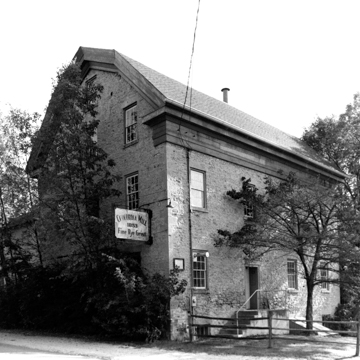This picturesque former hamlet was settled in the mid-1830s by Joseph Gardinier, a New Yorker who had helped build Green Bay Road, one of the first routes carved through the eastern Wisconsin wilderness. On the present site of the Concordia Mill, he erected a log house and a tavern, which in the 1840s became a social center for the Irish farmers who settled the area and nicknamed the community “New Dublin.” By 1847, however, when German immigrant residents objected to the Irish town name, the townspeople renamed it Hamilton. The hamlet’s prosperity proved short-lived; it all but died after the railroad bypassed this stage stop in favor of Cedarburg.
A number of the fieldstone buildings remain from Hamilton’s heyday. One of the more stately is the Greek Revival Edward and Frederika Janssen House (1854; 264 Hamilton Road). A veranda supported by square piers with simple capitals spans the house’s front, sheltering a central doorway surrounded by a wide architrave molding. Edward Janssen became state treasurer in 1851, making him the first German immigrant elected to a major office in Wisconsin.
In 1867, Janssen paid for the construction of the Turn Halle at 240 Hamilton Road, home to the local Turnverein, or German-speaking athletic club, which hosted lively social and cultural events. The walls of the large front-gabled building are of local fieldstone in a heavy mortar matrix. The dressed limestone quoins, symmetry of the round-arched windows, arched central entrance with fanlight, cornice returns, and semicircular fanlight below the gable apex lend Greek Revival formality to an otherwise rustic building. The Cedarburg Landmark Preservation Society has restored the building as a museum.
The hamlet felt Janssen’s influence in its economic life as well as its social life. In 1853, with his brother Theodore and William Gaitzsch, Janssen built the Concordia Mill at 252 Green Bay Road. The limestone rubble, three-and-a-half story building with a gambrel roof shows Greek Revival influences in the wide cornice molding with returned ends and dressed stone quoins. The turbine-driven mill produced “fine rye grist” but also operated a reciprocating saw for milling lumber.


